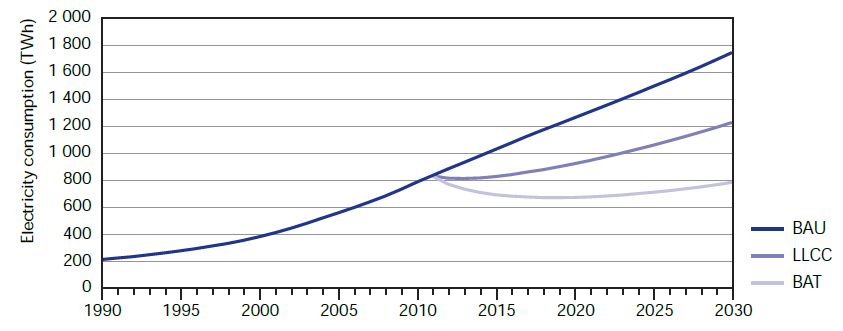
Photocatalytic Treatment of Wastewater
February 27, 2021
Important Recent Developments in Power Train Designs
February 27, 2021Research aim
The basic aim of this dissertation is to present critical analyses of the global trends in electricity consumption, energy efficiency programs and policy options. Recommendations to improve the energy efficiency of various electronic appliances will also be presented. The development of smarter electronic devices to improve energy efficiency will also be discussed along with the practical applications
Much research has been conducted in the last many decades to improve the energy rating of particular miscellaneous electronic devices, and various state of the art smart materials have been adopted. Discussion on these recent developments will be completed, which would require assessment and evaluation of both and quantitative qualitative research. Quantitative as well as quantitative data will be presented with focused research on various applications, policies and trends.
Research questions
The increasing energy security concerns around the globe have raised many questions, and the need to switch to more energy-efficient systems has now been the primary adopted method by various continental policymakers. The main research questions to be discussed in this dissertation include:
- How much energy can be saved by switching to the best available technology? What are the potential opportunities?
- Are there any policies designed to achieve long-term transformations? Are there standards of minimum energy performance?
- How the manufacturers have adopted these changes? Are electronic devices now being produced with lower energy ratings?
- Has this influenced the research and development of new electronic devices? Are there any design methods specific to these requirements?
- How does this affect Sustainability? Advantages and disadvantages with respect to future needs?
All these questions have motivated me to conduct research on this topic and select this subject of study as my dissertation course
Chapter – 2; Literature review
A number of applications that exist in the industrial and commercial world these days have come from power electronics. Essentially, power electronics ensure reliable, efficient and quick electrical power management by means of highly advanced technology. Thanks to the progress that took place in the world of power management, we can use mobile phones, tablets, Plasma TVs and computer networks. In reality, the possibility of making use of affinity laws has been created with the help of power electronics and efficient electric power management. Examples of such applications include BLDC applications and electric vehicles and washing machines and variable motor drives coupled to fans and pumps. This also shows how power electronics and technology have been incorporated into various products and processes nowadays. Electric tools, class D audio and energy-efficient lighting are some of the other applications of power electronics (Mohan et al., 2003)
There is no denying the fact that electronic and electrical engineers have played a key role in realizing this technology. Furthermore, a lot of effort has been made to learn methods of applying this technology. Researchers throughout the world have shown great intent toward acquiring this new skill set. However, it should be noted that the learners should have some mechanical background to be able to correctly understand the mechanism behind these applications as most of the time these applications use a mechanical system.
It has been observed that learning power electronics and electrical power management is more attractive and exciting in an environment where the properties of the final element of an application are explored in addition to examining the methods of controlling power electronic technology. In order to build a world-class academic profile in the fields of power electronics and electrical energy conversion, a significant number of Universities in the UK have been developed which are involved in the optimization of energy efficiency/conversion. However, according to the Department of Innovation and Skill strategy group of the UK, the industrial demand is higher than the number of enrolled students in these Universities.
Various trade associations in the UK have established industry-specific communities to assess and analyze the establishment of the state of the art communities. The European Centre for Power Electronics at the European level has been established to provide central support and focus on technology road-mapping (Power Electronics, 2011) Over the last many decades, the improvement in energy efficiency and its impacts on the environment and economic growth has provided numerous benefits to the people of this planet. Investors and administrators therefore should realize their responsibility and duties toward encouraging steady and continuous progress in the world of sustainable energy and fuel flexibility (Ross and Alan, 2005). There is also a need to encourage energy efficiency programs and technologies to be able to improve our standard of living, the efficiency of our transportation systems, factories, and offices and to control the factors that contribute to the efficiency of our homes and industries.
The effective electric load in each household can be defined as the combination of various electronic devices, products or equipment (Mohan, Uderland and Robbins, 2003). Other definitions of effective miscellaneous electric loads are the large end uses that occur in a small fraction of the small end uses occurring in a large fraction of our houses. Electric equipment such as microwave ovens, toasters, kettles, coffee makers, televisions, computers, mobile phones, laptops and tablets, well pumps, aquariums, fridges, freezers, heaters and electric motors are the typical electronic or electrical equipment that results in miscellaneous electric loads. Considering the diverse range of products and processes that contribute to these energy losses, it is extremely tough to find a system-based solution (Ross & Meier 2000). Furthermore, the behaviour and each occupant in operating and choosing these devices makes the job of controlling the total energy use of MELs much more complicated (Hendron 2005).
There is no denying the fact that it is very hard to control the factors affecting the use of energy and associated with reducing MELs but that must not stop us from looking into energy-based products to look for ways to improve energy consumption, and the overall performance of the electrical equipment in our houses (Wenzel et al. 1997). Considerable research has been performed already in an effort to identify the type and magnitude of most common MELs (Zogg & Alberino 1998). NREL has led this area of research to be able to find other similar but more energy-efficient methodologies and technologies (Little, 1999)
Lawrence Berkeley National Laboratory continued the work under this key area of study to identify home office equipment and other general consumer electronics to achieve greater energy savings (Rosen & Meier 1999a). Research has also been conducted to classify conventional plug loads and end use loads for small electronic products (Rosen & Meier 1999bIn the research conducted at the University of Newcastle Upon Tyne by Mecrow and Jach A.G. in 2008, it was found that through applying variable speed electric devices and integrating the driving load, the electrical drive efficiency can be improved. Through the adaptation of the proven concept, it possible it is possible to save up to 15 – 30 % of the energy of the systems which are driven by electrical machines. In the, UK, almost half of the total energy generated by rotational electric generators is consumed by electrical drive motors (Keulenaer et al., 2004) Therefore it can be concluded that even slight improvements in the energy efficiency of electrical machines can have a huge impact on the overall economy not only in Europe but all over the world.
However, it should be noted that regardless of occupants living patterns and decision-making, there is a need to develop a comprehensive system-based approach that involves both architect engineers and the construction company to achieve long-term and short-term energy saving goals.
Emergency Efficiency Impact
According to the International Energy Efficiency (IEA), 2007, worldwide electricity demand is on the rise, which is due to the rise in the demand for electrical appliances. The following figure-1 illustrates this quantitatively;

Figure-1: Rise of Electricity Consumption (residential) in various regions (source: IEA statics)
The efficiency of basic household electrical equipment has improved in the past, which has been partly due to the policies of governments; however, the ownership of items such as air conditioners, lighting, and other similar equipment has increased.
To cope with such changing trends around the globe, state of the art technologies have been developed, which hopefully would stabilize the increasing trend of electrical consumption. Some of the influencing technologies which are now being applied and being further developed are the new LED lights, Hybrid automotive technology, and multi-stage evaporative cooling systems for household and commercial buildings.
Just a few years ago, the light bulbs, which were normally rated as 60-150W, were consumed/used in almost every household. Within a decade, through research/development and policy implementations, energy savers with a rating of less than 25W were brought into the market. Today, domestic consumption is being switched to even more efficient LED lights. Similarly, it has been stated by various analysts that in the next few decades, the Hybrid Car Technology which is considered to be more energy efficient, is expected to replace the current transport vehicle types in the automotive industry.
Alternative technologies can have a huge impact on the total electrical requirements. The Business as usual (BaU) projected that through switching to the best available technologies (BAT), which also presents the least life cycle costs (LLCC), it would be possible to save more than 30% of the total expected consumption. This is illustrated in the following figure-2;

Figure-2: Electricity saving estimates (source: IEA estimates)
Therefore, it can be stated that stimulating the sustainable market(s) to develop state-of-the-art energy-efficient systems can prove to be extremely important in the near future. Through the government-level implementation of new policies, it can be expected that the next few decades will show improvements in the design through maturing the electrical-mechanical designs of machines run on variable speed derived. The potential efficient movement drives combined with the efficiency gains through the increase of drive efficiency can save up to 24 billion kWh per year in the United Kingdom (Mecrow and Jack, 2008).
The world leaders in the manufacturing industry have already realized this as their key performance parameter. Case studies on specific equipment development with respect to the subject parameter can prove to be as useful methods to understand how the product development strategies have evolved and, from the engineering point of view, how these equipment has been designed to be energy efficient.

Figure-3: Understand power electronics, an integrated method (source: Kulatunga, 2008)
One such case study has been completed by Kulatunga and Bastick in 2009, in which the energy-saving potential of motors was assessed using the variable speed motors with the damp control, speed drive and vane control systems. From the results obtained, the researcher concluded that various aspects of engineering models and equipment can be improved concerning energy savings through the application of optimized control systems and materials. The writer further recommended that there is a need to explore such opportunities and so that various applications can be re-engineered with respect to efficient energy utilization.
Chapter – 3; Methodology
The conducted multi-method research approach along with the presentation of the primary as well as secondary data collection will be included in this section. Application of inductive type approach will be presented to structure the layout of the methodology used; for various electronic devices, especially in domestic use. The approach recommended by various previous research articles will also be discussed in this section.
Chapter – 4; Findings (Results and Discussion)
This section would include the results and discussion based on structured arguments from the previous sections of the paper. Quantitative, as well as quantitative analyses of the primary and/or secondary data, will be included in this section. Furthermore, this section would recommend viable options and benefits/opportunities based on the literature review section of the paper.
Chapter – 5; Conclusions
Energy Efficiency of all the products and systems must be considered not only in the aspects of product development but also because of its global influence and environmental impact. The development of state of the art power electronic device can increase energy efficiency and improve cost-effectiveness. It can also help balance energy demands and production. Due to the recent energy security concerns, technologists and engineers are being motivated to help in saving energy and develop/explore new smarter methods of efficient technology
References
Hendron, R,. (2005). Building America Research Benchmark Definitio. NREL Report No. 37529. Golden, National Renewable Energy Laboratory.
Hendron, H., and Eastment, M., (2006). Development of an Energy-Savings Calculation Methodology for Residential Miscellaneous Electric Loads, National Renewable Energy Laboratory, Conference Paper NREL/CP-550-39551
International Energy Agency (IEA), (2009). Gadgets and Gigawatts. Policies for Energy Efficiency . Available online at: <http://www.iea.org/publications/freepublications/publication/name,3807,en.html> [Retrieved on 19 November 2013]
Keulenaer, H., Belmans, R., Blaustein, E., et al., (2004). Energy Efficient Motor Driven Systems. EU-sponsored programme. European Copper Institute.
Kulatunga, A., Persson, E., Sundararajan, R. and Herrick, R. (2007). Energy saving potential and characteristics of motors for consumer appliances, Proceedings of the IEEE EIC/EME Conference, TN
Kulatunga, A. and Bastick, M., (2008) Power Electronics for Energy Efficiency - Integrating Commercial Drive Development Platforms and Pumps for Real World Learning. The Technology Interface. Available online at: <http://technologyinterface.nmsu.edu/Spring08/32_Kulatunga/index.pdf> [Retrieved on 19 November 2013]
Little. D., (1999). Opportunities for Energy Savings in the Residential and Commercial Sectors with High-Efficiency Electric Motors. Cambridge, Mass.: Arthur D. Little.
Meier, A., (2002). Research Recommendations to Achieve Energy Savings for Electronic Equipment Operating in Low Power Modes. LBNL-51546. Berkeley, Calif.: Lawrence Berkeley National Laboratory.
Mecrow, B.C. and Jack, A.G., (2008). Efficiency trends in electric machines and drives, Energy Policy Volume 36, Issue 12. Available online at Science Direct; <http://www.sciencedirect.com/science/article/pii/S0301421508004461> [Retrieved on 22 November 2013]
Mohan, N., Robbins, W. P., Imbertson, P., Undeland, T. M., Panaitescu, R. C., Jain, A. K., Jose, P. and Begalke, T. (2003), Reconstructing of first courses in power electronics and electric drives that integrates digital control. IEEE Transactions on Power Electronics, (Jan. 2003): 429-437
Mohan, N. Underland, T. M. and Robbins, W.P., (2003), Power Electronics: Converters, Applications, and Design, John Wiley & Sons, NJ, ISBN 0-471- 22693-9
Morimoto, S., Takeda, Y. and Murakami, H. (2002). Motors for Home Applications: Development of Environment-Friendly Electric Motors. European Power , Electronics Conference
National Energy Strategy, Executive Summary, (1992). Washington, D.C.,U.S. Dept. of Energy
Nordman, B., (2004). Developing and Testing Low Power Mode Measurement Methods. California Energy Commission Report P500-04-057-A1. Berkeley, Calif.: Lawrence Berkeley National Laboratory.
Persson, E., Kulatunga, A., Sundararajan, R., and Herrick, R. (2007). Challenges of applying variable speed motor drives for consumer appliances, Proceedings of the IEEE EIC/EME Conference, TN
Power Electronics, (2011): A Strategy for Success, Power Electronics Strategy Group, UK.
Rosen, K. and Alan, M. (1999a). Energy Use of Home Audio Products in the U.S. LBNL-43468. Berkeley, Calif.: Lawrence Berkeley National Laboratory.
Rosen, K. and Alan, M., (1999b). Energy Use of Televisions and Videocassette Recorders in the U.S. LBNL-42393. Berkeley, Calif.: Lawrence Berkeley National Laboratory.
Ross, J. P. and Alan, M., (2000). Whole-House Measurements of Standby Power Consumption. In Proceedings of the Second International Conference on Energy Efficiency in Household Appliances. Naples, Italy: Association of Italian Energy Economics (Rome). Also published as Lawrence Berkeley National Laboratory Report LBNL-45967.
Wenzel, T., Jonathan, K., Gregory R., Marla. S. and James H., (1997). Energy Data Sourcebook for the U.S. Residential Sector. Berkeley, Calif.: Lawrence Berkeley National Laboratory
Zogg, R. and Deborah A., (1998). Electricity Consumption by Small End Uses in Residential Buildings. Cambridge, Mass.: Arthur D. Little, Inc.
Strategy – Design- Utilization





















